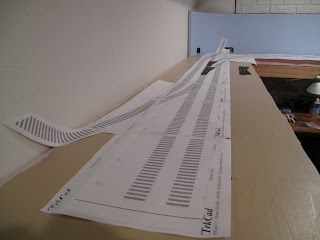
After pondering alternatives for the backdrop on the new north wall section, I decided to go ahead and extend the existing 1/8" masonite backdrop and just cut out a hole for the thermostat that's there. The backdrop is only 14" high - I might end up wishing it was taller before I'm all done, but at this point it was easier to extend what I already had there. I can always make it taller later if I really want to, but I think this will work out OK.

I also managed to get all ten turnouts laid along with most of the track. I decided to solder all of the rail joiners. I've seen posts extolling the virtues of soldering and of not soldering, so I decided to play it safe and solder. I figure that being in a basement the temperature won't vary that much and the dehumidifier will keep the humidity level relatively stable. Also, since the longest dimension is only 9 feet, I can't imagine that there will be enough expansion or contraction to cause any problems.

This is the opening in the northwest corner that goes to the small staging tracks.

Looking towards the northwest corner.

The canal area.

For track feeders, I am using a heavier gauge doorbell wire (20 gauge solid I believe). I solder these to the bottom of the rail joiners roughly every 3 feet or so. They feed through to the underside of the shelf and then are soldered to the 14 gauge solid bus wires that run under the table.
For now I have my cheapie MRC power pack soldered to the bus wires just to be able to run my sole engine back and forth.

This is looking at the bottom of the layout. The bus wires are regular old 14 gauge solid (stripped from romex). The smaller feeder wires are soldered to the bus wires and feed up through the plywood and foam to the tracks above.
The warehouse mockups are currently nothing more than 1/4" styrofoam and miscellaneous boxes. I am planning to build these warehouse buildings primarily out of styrene plastic. I'm going to have to do some research to see where I can get the detail parts. Again, I'll rely heavily on descriptions by other modelers on internet sites to see how they did this. I imagine things like roll-up doors could be made out of some sort of currugated styrene stock.
Thinking about it, I imagine that my order of proceeding from here would go something like this -
1. Complete laying track and installing feeder wires.
2. Verify flawless operation of the track by running strings of cars at high and low speed through the various combinations of turnouts. Iron out any problems before doing anything else.
3. Complete any additional backdrop painting - probably just another coat of blue, I don't think I'm going to fool around with painting clouds or what-not.
4. Paint the track a uniform color. Thinking some sort of gray-ish wash for the ties and some rusty-ish color for the rails.
5. Establish the exact dimensions for the various buildings and build correctly sized mockups as place holders. The mock-ups I have in place now are very rough and the dimensions were pretty arbitrary.
6. Decide on the exact location of the canal and carve away the appropriate amount of foam.
7. Install ballast on the track
8. Start work on ground scenery, trees, shrubbery, etc.
9. Start building the "real" warehouse buildings to replace the mockups.
Another thing I need to be thinking about is some sort of rudimentary video system so that i can see what is happening on the staging tracks.
Lots of fun little projects.






















